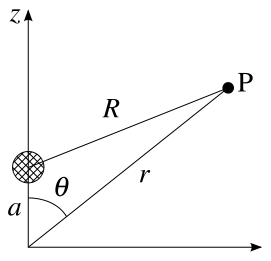Axial multipole moments
Axial multipole moments are a series expansion of the electric potential of a charge distribution localized close to the origin along one Cartesian axis, denoted here as the z-axis. However, the axial multipole expansion can also be applied to any potential or field that varies inversely with the distance to the source, i.e., as . For clarity, we first illustrate the expansion for a single point charge, then generalize to an arbitrary charge density localized to the z-axis.

Axial multipole moments of a point charge
The electric potential of a point charge q located on the z-axis at (Fig. 1) equals
If the radius r of the observation point is greater than a, we may factor out and expand the square root in powers of using Legendre polynomials
where the axial multipole moments contain everything specific to a given charge distribution; the other parts of the electric potential depend only on the coordinates of the observation point P. Special cases include the axial monopole moment , the axial dipole moment and the axial quadrupole moment . This illustrates the general theorem that the lowest non-zero multipole moment is independent of the origin of the coordinate system, but higher multipole moments are not (in general).
Conversely, if the radius r is less than a, we may factor out and expand in powers of , once again using Legendre polynomials
where the interior axial multipole moments contain everything specific to a given charge distribution; the other parts depend only on the coordinates of the observation point P.
General axial multipole moments
To get the general axial multipole moments, we replace the point charge of the previous section with an infinitesimal charge element , where represents the charge density at position on the z-axis. If the radius r of the observation point P is greater than the largest for which is significant (denoted ), the electric potential may be written
where the axial multipole moments are defined
Special cases include the axial monopole moment (=total charge)
- ,
the axial dipole moment , and the axial quadrupole moment . Each successive term in the expansion varies inversely with a greater power of , e.g., the monopole potential varies as , the dipole potential varies as , the quadrupole potential varies as , etc. Thus, at large distances (), the potential is well-approximated by the leading nonzero multipole term.
The lowest non-zero axial multipole moment is invariant under a shift b in origin, but higher moments generally depend on the choice of origin. The shifted multipole moments would be
Expanding the polynomial under the integral
leads to the equation
If the lower moments are zero, then . The same equation shows that multipole moments higher than the first non-zero moment do depend on the choice of origin (in general).
Interior axial multipole moments
Conversely, if the radius r is smaller than the smallest for which is significant (denoted ), the electric potential may be written
where the interior axial multipole moments are defined
Special cases include the interior axial monopole moment ( the total charge)
- ,
the interior axial dipole moment , etc. Each successive term in the expansion varies with a greater power of , e.g., the interior monopole potential varies as , the dipole potential varies as , etc. At short distances (), the potential is well-approximated by the leading nonzero interior multipole term.